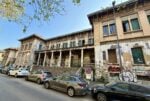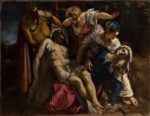John Ratner – Il mistero della Terra cava
.jpg)
Pittore colto e soave, nonché competente naturopata ed omeopata, John Ratner è un uomo d’altri tempi, ideale discepolo dei fisiologi presocratici ed allievo degli artisti-scienziati del Rinascimento.
Comunicato stampa
John Ratner: “Il Mistero della Terra Cava”
Pittore colto e soave, nonché competente naturopata ed omeopata, John Ratner è un uomo d’altri tempi, ideale discepolo dei fisiologi presocratici ed allievo degli artisti-scienziati del Rinascimento. La sua pittura, gioiosamente estranea alle mode del momento, insegue il sogno e cerca la verità, perché l’arte – secondo una linea che da Leonardo arriva a Paul Cézanne – è per lui strumento privilegiato per conoscere il mondo e per comprenderne i meccanismi. Il suo studio, stracolmo di piccoli tesori come la bottega dello Squarcione o l’antico museo di Ferrante Imperato, è una camera delle meraviglie dove si affollano dipinti finiti e non finiti insieme a reliquie esotiche e alambicchi, libri antichi e moderni, insetti essiccati e mappe stellari.
Nella Roma della “dolce vita” Ratner incontrava Lucrezio, imparava ad amare i suoi versi venuti da un mondo lontano e iniziava a tradurre in pittura quella filosofia di vita capace di porre attenzione a ciò che è piccolo. Da quel momento le capitali classiche del latino arcaico e solenne del De rerum natura non hanno mai smesso di stagliarsi sul fondo scuro dei suoi quadri e sui bordi delle loro cornici. Fitte griglie di lettere d’oro che ingabbiano la composizione e illuminano il riguardante sul concetto epicureo di materia contrapposto a quello di vuoto: «che poi tutto l’insieme delle cose possa porsi da sé stesso un limite lo vieta la natura, la quale costringe la materia a essere limitata dal vuoto e quanto è vuoto a essere limitato dalla materia, sì che con la loro alternanza rende infinito il tutto» (De rerum natura, libro I).
Frutto di quarant’anni di studi di John sull’affascinante mistero della Terra cava, questa mostra costituisce il primo tributo artistico a questa antica ma poco nota teoria, formulata nell’Inghilterra del XVII secolo e fiorita sino ai nostri giorni in diverse recenti monografie. Nel corso del Seicento, infatti, si sedimentarono negli studi ufficiali alcune dottrine scientifiche e pseudoscientifiche che, in modo più o meno sotterraneo, sono perdurate ben oltre il Secolo dei Lumi.
Discepolo ideale dell’ingegnoso Sir Halley e dell’impavido Rear Admiral Byrd, John Ratner ha raccolto doviziosamente l’eredità dimenticata di quei primi teorici della Terra cava, rendendo intuitivamente comprensibile il loro insegnamento esoterico attraverso il linguaggio universale della pittura. Le sofisticate immagini poetiche dei suoi dipinti, tratte dai versi del De rerum natura e dal regno animale e vegetale, raccontano un altro modo di pensare agli abissi del nostro pianeta, luoghi fisici e metafisici capaci di innescare una nuova rivoluzione copernicana.
Yuri Primarosa – dal Catalogo della mostra: “Il mistero della Terra Cava”.
John Ratner: “The Hollow Earth Mystery”
A poised and sophisticated painter, as well as a naturopath and homeopath, John Ratner is yet an old-school kind of guy, the ideal disciple of pre-Socratic philosophers, and an apprentice of Renaissance artists/scientists. His paintings, joyfully extraneous to trends, follow a dream and seek truth, since Art—following the footsteps that from Leonardo da Vinci lead to Paul Cézanne—is for him the right instrument to know the world and eventually its mechanisms. Ratner’s studio, a sanctuary of small treasures as the shop of Francesco Squarcione (c. 1395-after 1468) or the old museum of Ferrante Imperato (c. 1525-c. 1615), is a chamber of marvels where one can find finished and unfinished paintings together with exotic relics and alembics, old and new books, dried insects, and stellar maps.
In Rome’s “Dolce Vita” Ratner learned how to appreciate Lucretius and admire his verses written in a remote past. Always in Rome, Ratner began to put on canvas life’s philosophy that emphasizes the small. From that moment on the classical capitals of the De rerum natura were a constant in Ratner’s dark backgrounds found in his paintings and on their frames. Thick grids of golden letters encompass the composition and illuminate the beholder on the epicurean concept of matter as it contrasts the void: “That, too, the sum of things itself may not Have power to fix a measure of its own, Great nature guards, she who compels the void To bound all body, as body all the void, Thus rendering by these alternates the whole An infinite” (De rerum natura, liber I).
John’s art show rests upon forty years of research on the fascinating mystery of Hollow Earth; it is the first artistic tribute to this ancient, yet little-known theory, which began in 17th-century England and continues to the present day. In the 1600s, scientific and pseudoscientific studies rose which somehow managed to linger beyond the Enlightenment.
Ideal disciple of the ingenious Sir Halley and of the fearless Rear Admiral Byrd, John Ratner has cleverly collected the forgotten details left behind by the first theorists of the Hollow Earth, eventually making intuitively intelligible their esoteric teachings through the universal language of painting. The sophisticated poetic images of his paintings, inspired by the verses of the De rerum natura and of the animal and vegetable worlds, narrate another way of thinking about the abyss of our planet, physical and metaphysical places capable of triggering off a new Copernican revolution.
Yuri Primarosa – from the Catalogue of the Exhibition: “The Hollow Earth Mystery”



